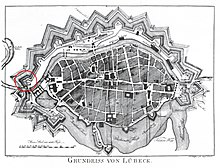Lübeck open-air theater
The Lübeck open-air theater is located in the Lübeck ramparts on the southeastern edge of Lübeck's old town .
history

At the suggestion of Paul Brockhaus , the Lübeck open-air theater was opened on June 6, 1927 to celebrate 700 years of imperial freedom in the city. The plant was the responsibility of the municipal horticultural inspector Rudolf Engehausen (1894–1943). It is embedded in a bastion called the Leutnantkuhle or Buniamshof of the Lübeck bastion fortification between the southern Wallstraße at the height of the Wipperbrücke and the Buniamshof stadium . During the Weimar Republic it was primarily used by theater groups from Lübeck schools and the Bündische Jugend . It initially had a capacity of 1200 seats and 1000 standing places. One of the first directors of the open-air theater was the Lübeck cultural critic Abram B. Enns from 1929 to 1933 . He was followed by the initiator Paul Brockhaus from 1934 to 1939.
In June 1931, Hugo Distler's Luther cantata for the 400th anniversary of the introduction of the Reformation was premiered here in Lübeck.
Today the Lübeck summer operetta, children's theater performances and occasional open-air concerts take place on the open- air stage.
literature
- Open-air stage in: Lübeck Lexikon , Lübeck 2006, p. 112
Web links
Individual evidence
- ^ Barbara Distler-Harth: Hugo Distler. Life path of an early completed. Schott Music, Mainz 2008, ISBN 978-3-7957-0182-6 , pp. 97 and 347
Coordinates: 53 ° 51 ′ 29 ″ N , 10 ° 41 ′ 2 ″ E
